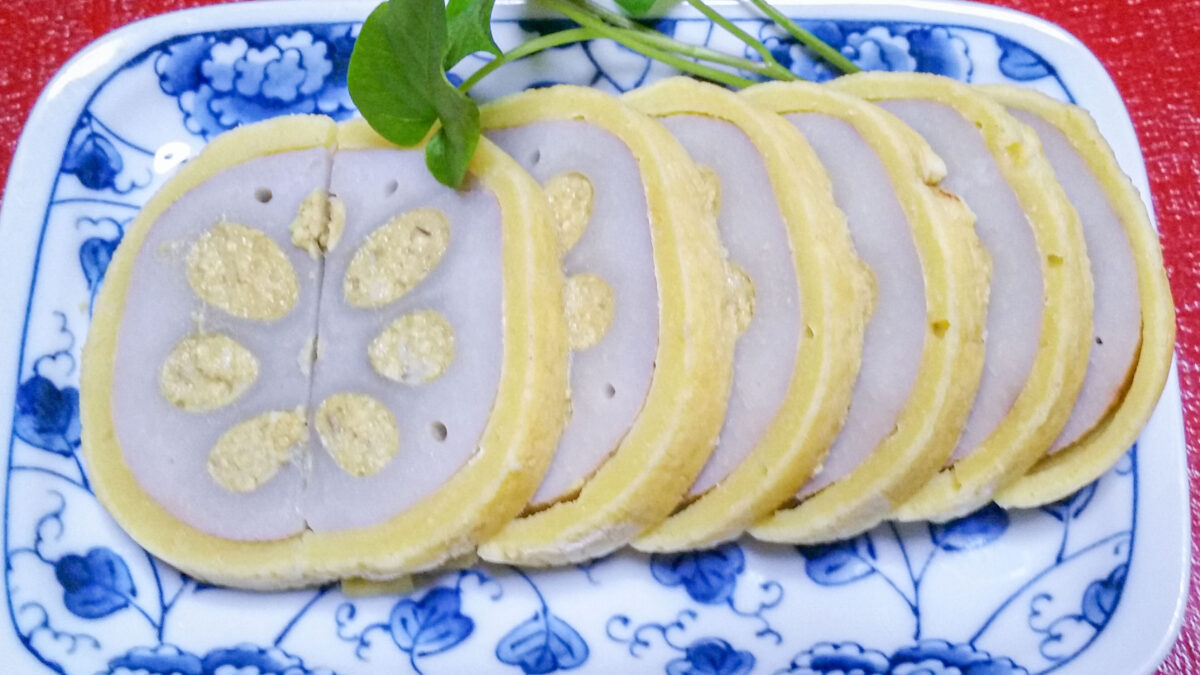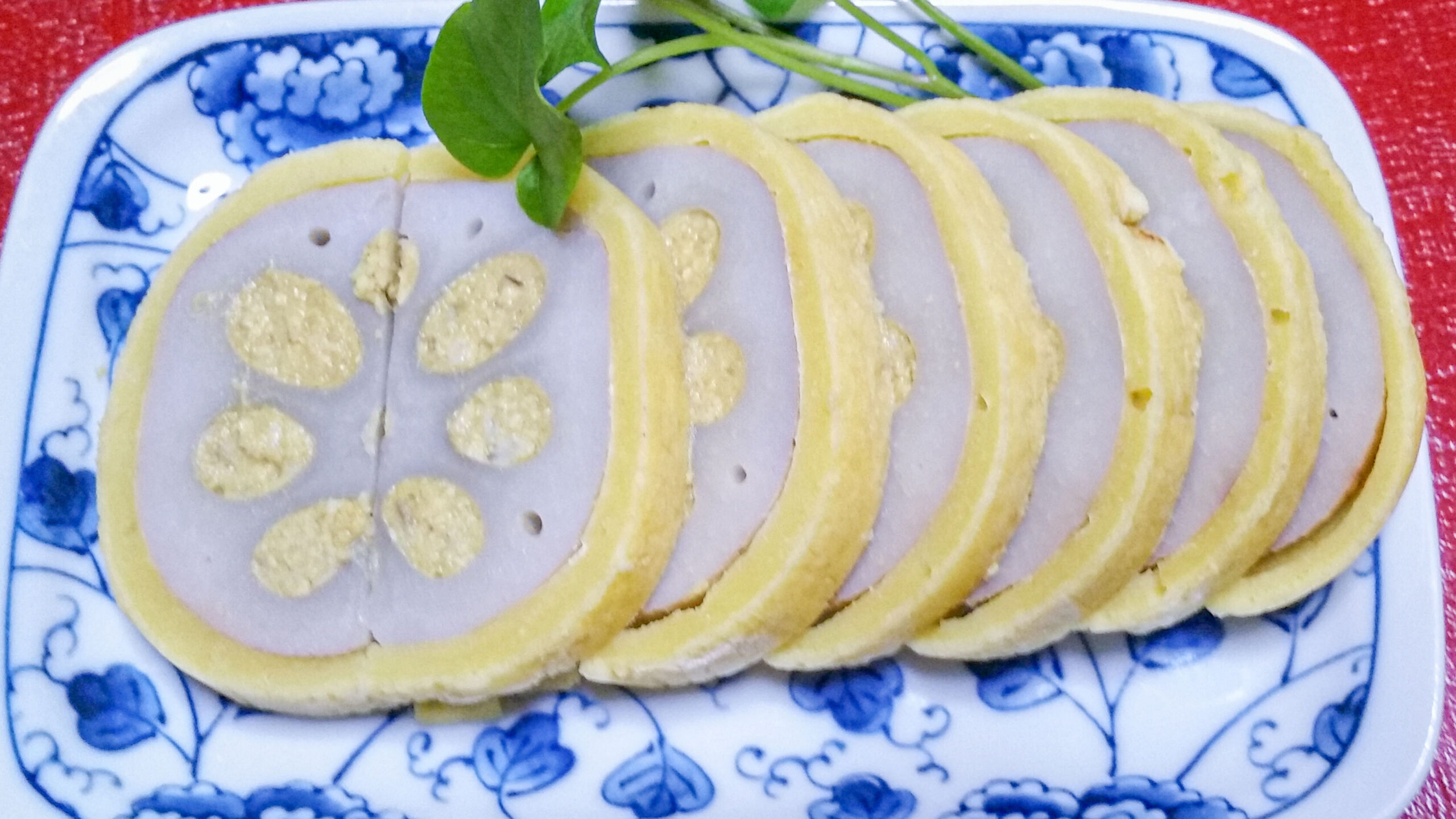
Hey there! Have you ever tried something that’s got a bit of a surprising kick? Let me tell you about *karashi renkon* from Kumamoto Prefecture. It’s basically lotus root that’s stuffed with a fiery mustard miso paste, battered, and then deep-fried to golden perfection. Sounds interesting, right? Well, there’s a cool story behind it too, linking it back to the powerful Hosokawa clan. It’s got this crunchy texture from the lotus root and a real punch from the mustard – definitely a conversation starter and a tasty treat!
Dish Name: Karashi Renkon
- Region / Location: Kumamoto Prefecture
- Primary Area of Tradition: Kumamoto region
- Main Ingredients: Lotus root (renkon), miso, powdered mustard (karashi), oil.
How It’s Eaten / Served
*Karashi renkon* is typically sliced into rounds, about 5 to 10 millimeters thick, so you can see the distinctive pattern that resembles the nine-star crest (kuyo-mon) of the Hosokawa clan. It’s usually eaten as is, and some people enjoy it with a touch of soy sauce or mayonnaise. Interestingly, folks have also come up with creative ways to enjoy it, like using it in croquettes, sandwiches, or even burgers. The mustard flavor is said to pair surprisingly well with bread, kind of like a Japanese take on mustard.
Cultural Background and Preservation
Kumamoto Prefecture is a major producer of lotus root in Japan. *Karashi renkon* has a fascinating history connected to the Hosokawa clan. Back in 1632, Lord Tadatoshi Hosokawa, the first lord of the Higo Hosokawa domain, was often in poor health. A worried monk from Rakanji Temple, Gen-taku Oshō, sought a nutritious food for him. Knowing that lotus root grew abundantly in the swampy areas of Kumamoto and was known for its blood-boosting properties in traditional medicine, he wanted Lord Tadatoshi to eat it. However, the lord refused, considering lotus root “impure” because it grew in mud. So, the monk devised a plan: he filled the holes of the lotus root with a mixture of miso and Japanese mustard, coated it in a batter of wheat flour, broad bean flour, and egg yolk, and then deep-fried it. The spicy kick of the mustard worked wonders! Lord Tadatoshi enjoyed it so much that it became a regular part of his diet, and his health improved significantly. The round slices of *karashi renkon* also resembled the Hosokawa clan’s nine-star crest. Lord Tadatoshi valued this dish and kept its preparation method a secret until the Meiji Restoration. This is why *karashi renkon* is still primarily produced and enjoyed in Kumamoto Prefecture. Today, it’s a popular side dish, a great accompaniment to drinks, and an essential part of New Year’s *osechi ryori* (traditional New Year’s food). You can find it not only in specialty stores but also in local supermarkets and souvenir shops, as well as on the menus of local restaurants and izakayas (Japanese pubs). Many establishments use lotus root from local contract farmers, and some specialty stores even grow their own.
Additional information:
- Lotus Root (Renkon): The root of the lotus plant, known for its crunchy texture and distinctive holes. It’s a popular vegetable in Japanese cuisine.
- Miso: A Japanese seasoning produced by fermenting soybeans (often with rice or barley and salt), resulting in a thick paste used for sauces, spreads, and soups. White miso is generally sweeter and milder than darker varieties.
- Powdered Mustard (Karashi): Japanese mustard, which is typically more pungent and has a hotter kick compared to Western mustard. It’s often mixed with water to form a paste.
- Osechi Ryori: Traditional Japanese New Year’s food, consisting of a variety of dishes packed in special boxes (jubako), each with symbolic meaning for the new year.
- Kuyo-mon: The nine-star crest, which is the family crest of the Hosokawa clan in Japan. The sliced rounds of *karashi renkon* resemble this crest.
The information about regional cuisine featured on this website (Piggy's Grandma of Japan) is summarized and adapted from the Ministry of Agriculture, Forestry and Fisheries of Japan (MAFF) website, "Our Regional Cuisines"Additional commentary is provided based on the unique experiences and perspectives of the site's editors.
The copyright for the original content regarding regional cuisine belongs to the Ministry of Agriculture, Forestry and Fisheries of Japan.
The summaries and adaptations published on this site are intended for informational purposes only. Piggy's Grandma of Japan does not guarantee the accuracy or completeness of this information. For the most accurate and complete details, please refer to the original pages on the MAFF website.


